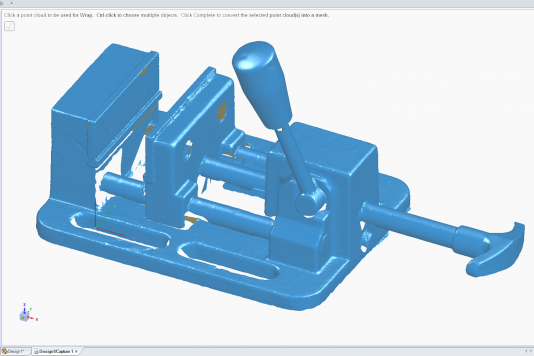The product combines Geomagic point cloud and mesh editing expertise with SpaceClaim’s direct modeling technology. New technologies had to be created to make the product possible.
Last week at Euromold Geomagic announced a new product that combines 3D point cloud data, mesh editing, and MCAD solid modeling in one product. Geomagic Spark is the result of a close collaboration between Geomagic—best known for its tools for converting and editing 3D point cloud data—and SpaceClaim, maker of the direct modeling MCAD tool that caused a stir when it was first released in 2007.

The Geomagic Spark workflow simplified a process that has been until now been time-consuming and expensive, to take 3D scan data, convert it into a polygon mesh, convert the mesh into solids, and convert it for use in an MCAD product. In Spark the user loads the point cloud data which is immediately converted into useful mesh and can be saved as a solid model.
Geomagic says Spark is the software product that will democratize the use of 3D scanning in product design. Scanning hardware (from vendors such as Creaform, Hexagon, and Faro) is coming down in price; Geomagic thinks the time is right to match these new scanners with a product priced more like SolidWorks than Catia. As of this writing, Geomagic has not released the price for Spark, but hints it will be priced similar to products like Autodesk Inventor, Dassault Systèmes SolidWorks, and Siemens PLM Solid Edge. A free trial version of Spark will be available January 28, 2013, with the commercial release to follow.
Geomagic and SpaceClaim both had to create new technology specifically for Spark. SpaceClaim already had an application programming interface (API) which could be used to create custom extensions, but several new procedures were required. Geomagic needed to develop a new DirectX-based graphics engine from the ground up for Spark.
Geomagic and SpaceClaim started their collaborative work when SpaceClaim integration was added to the 2012 release of Geomagic Studio. Positive feedback from users led the two to start work on a fully integrated product, which resulted in Spark.
The only direct competitor to Spark is Rapidform XOR, a competitor to Geomagic Studio which in the last release or two has added direct modeling features. The difference is that Spark unites two existing robust software tools, while Rapidform XOR adds rudimentary direct modeling to their scan conversion. South Korea-based Rapidform was acquired earlier this year by 3D Systems, which is intent on assembling a proprietary platform for all stages of the digital reality process.

Our take
Geomagic is positioning Spark as the new CAD product for someone who wears many hats in a product development organization, or is perhaps the entire product development organization. They see anyone that designs in 3D based on existing parts, including reverse engineering, as a target customer. They estimate 90% of all product designers are not using 3D scan data today, but would consider it if the cost of the software would drop and the path from scan to model shrink.
Adoption might be slow at first, which is probably why Geomagic is releasing in a free trial before the commercial version ships. If Spark works as promised, word of mouth in the product development community will give it a lift.





